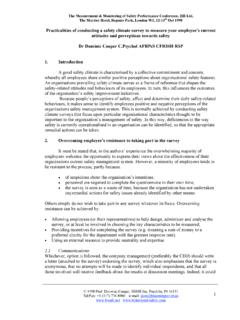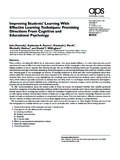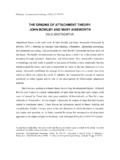Transcription of An online version of the Mooney Face Test phenotypic and ...
1 Neuropsychologia 63 (2014) 19 25. Contents lists available at ScienceDirect Neuropsychologia journal homepage: An online version of the Mooney Face Test: phenotypic and genetic associations Roeland J. Verhallen a,n, Jenny M. Bosten a, Patrick T. Goodbourn a,b, Gary Bargary c, Adam J. Lawrance-Owen a, Mollon a a Department of Psychology, University of Cambridge, Downing Street, Cambridge CB2 3EB, United Kingdom b School of Psychology, University of Sydney, Brennan MacCallum Building, Sydney, NSW 2006, Australia c Applied Vision Research Centre, City University London, Northampton Square, London EC1V 0HB, United Kingdom art ic l e i nf o a b s t r a c t Article history: The Mooney Face Test is a widely used test of face perception, but was originally designed to be Received 2 April 2014 administered by personal interview.
2 We have developed a three-alternative forced-choice version for Received in revised form online testing. We tested 397 healthy adults between the ages of 18 and 42 (M 24 years). There was a 8 August 2014. wide range of performance (64 100% correct; M ). We observed a signi cant sex difference Accepted 10 August 2014. Available online 17 August 2014. favoring males (.31 standard deviation; p .004). In addition, independently of sex, higher 2D:4D digit ratios were signi cantly associated with higher scores ( .14, p .006). A genome-wide association Keywords: study (GWAS) for a subset of 370 participants identi ed an association between Mooney performance Face perception and a polymorphism in the RAPGEF5 gene (rs1522280; p " 10 # 8). This association survives a Mooney Face Test permutation test (p.)
3 031). Closure & 2014 Published by Elsevier Ltd. Gestalt perception Individual differences Genome-wide association study (GWAS). RAPGEF5. rs1522280. 1. Introduction and serial evaluation and compilation of elements. It is considered a test of holistic processing: inversion of the images makes recogni- The cortical processing of faces encompasses a complex sequence tion almost impossible (Kanwisher, Tong & Nakayama, 1998), con- of stages, including the visual extraction of features, the analysis of rming that the viewer is unlikely to be using isolated features to their con guration, the matching of this con guration with a identify the hidden face. possible existing memory, and the subsequent recognition of known The still-mysterious process of closure the preconscious com- faces (Bruce & Young, 2012).
4 Many tests have been developed to putation that precedes the emergence of a complete percept . assess various aspects of face processing (Young, Hellawell, & Hay, seems to play an important role in the Mooney Face Test. 1987; Duchaine & Nakayama, 2006; Burton, White, & McNeill, 2010). Wasserstein, Barr, Zappulla, and Rock (2004) administered four However, for more than half a century, neuropsychologists have closure tests and one face-matching test to patients with unilateral recognised the value of the classic Mooney Face Test ( Mooney , 1956, brain damage, and by means of a factor analysis identi ed two 1957; Milner, Corkin, and Teuber 1968; Newcombe & Russell, 1969; factors: a closure factor and a facial discrimination factor. They Wasserstein, Zappulla, Rosen, Gerstman, & Rock, 1987; Rizzo, observed that the Mooney Face Test loaded more heavily on the Nawrot, & Zihl, 1995).
5 The Mooney Face Test ( Mooney , 1956, 1957) closure factor (shared variance: 55% for left-sided cases, 62% for comprises forty black and white images in which a certain combina- right-sided) than on the facial discrimination factor (shared tion of pure black (shaded) and pure white (lit) parts gives rise to the variance: 14% and 18% for the two groups). However, Foreman image of a face (see Fig. 1). Perception of the two-tone Mooney (1991) reported no relationship between performance on the gures is all or none: the complete percept of the face emerges Mooney Face Test and performance on the Gollin Incomplete suddenly from an array of patches rather than through a conscious Figures Test, on the Poppelreuter test, or on a visual search task. Young, De Haan, and Newcombe (1990) reported a patient ( SP').
6 Who showed marked impairments on various tests of face proces- n Corresponding author. Tel.: 44 1223 333 580. sing (including the Mooney Face Test), but who could distinguish E-mail address: ( Verhallen). faces from other objects, whereas other prosopagnosic patients 0028-3932/& 2014 Published by Elsevier Ltd. 20 Verhallen et al. / Neuropsychologia 63 (2014) 19 25. Fig. 1. An example of a trial from our modi ed Mooney Face Test. One of the three images (in this case, number 1) is an original Mooney face, and the other two are custom- made distractors. may retain normal performance for Mooney faces while being performance on the test to sex, to Autism-Spectrum Quotient impaired in the holistic perception of individual faces (Busigny, and to digit ratio. Joubert, Felician, Ceccaldi, & Rossion, 2010).
7 In fMRI studies, Although the heritability of performance on the Mooney test is Kanwisher et al. (1998) found much stronger responses in the unknown, recent twin studies suggest a strong heritable compo- fusiform face area (FFA) to upright Mooney faces than to inverted nent to performance on other tests of face processing (Wilmer ones, while Andrews and Schluppeck (2004) found that the et al., 2010; Zhu et al., 2010). For example, for the Cambridge Face response in the FFA to Mooney faces was stronger when the face Memory Test, Wilmer et al. (2010) found correlations of .70 and was actually perceived a distinction that was not observed for the .29 for monozygotic and dizygotic twin pairs respectively. Brown face regions of the superior temporal sulcus. Thus it remains et al.
8 (2012), in a whole-genome association study, found genetic unresolved to what extent the Mooney Face Test is a test of associations with increased brain activity evoked in the FFA by the closure, and to what extent it is a speci c test of face processing. presentation of affective facial expressions. However, no research In neuropsychological studies, impairment on the Mooney test has so far been conducted to nd speci c genetic correlates of the has been associated with damage to the right hemisphere, and to psychophysical ability to detect faces . Most of our participants had the temporal lobe in particular. Freda Newcombe, in her series of earlier taken part in a genome-wide association study (GWAS); we patients with unilateral focal missile wounds, found that right- are thus in a position to report preliminary genetic associations hemisphere cases were impaired on the Mooney test but left- with performance on our version of the Mooney Face Test.
9 Hemisphere cases did not differ signi cantly from controls (Newcombe & Russell, 1969; Newcombe, 1974). In a group of epileptic patients who had undergone unilateral resection of the temporal lobe, Lansdell (1968) found reduced scores on the 2. Materials and methods Mooney test after right-sided resection. A similar asymmetry was observed by Wasserstein et al. (2004); see above. In its Participants disproportionate vulnerability to right-hemisphere damage, the Mooney test resembles other tests of face perception (H caen, Our 397 participants (252 female) were a subset of a cohort of 1060 who had 1962; Warrington & James, 1967; Yin, 1970; Newcombe, De Haan, previously completed a battery of perceptual tests in our laboratory as part of the Ross, & Young 1989; Busigny et al.)
10 , 2014). PERGENIC project (Goodbourn et al., 2012, 2014; Lawrance-Owen et al., 2014;. Sex differences for the Mooney Face Test have been reported by Bosten et al., 2014a, 2014b). Participants were healthy young adults between the ages of 18 and 42 (M 24 years), all of European descent. The majority were Foreman (1991), who observed a signi cantly shorter reaction students from the University of Cambridge. Although the present tests were time for males than for females. Vigen, Goebel, and Embreem conducted online , all the participants were known to us from their previous visit (1982) reported that sex accounts for of the variance in to the laboratory. In the PERGENIC study, other potentially relevant phenotypic data performance on the Mooney Face Test, additionally observing that were collected, including handedness, personality, Autism-Spectrum Quotient (AQ), females' performance declines with increasing age while that of and digit ratio.




